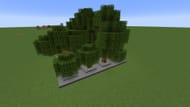Minecraft players often have a recurring need for the game's various base resources, including wood and stone. While players can roam around cutting down trees to gather wood, this can be time-consuming. In this light, developing a tree farm for easy access to wood resources for the foreseeable future is never a bad idea.
One of the upsides of tree farms in Minecraft is that they can be designed as simply or as complex as players would like. They can begin with a basic farm and then upgrade it over time or simply create an entirely new farm structure.
If Minecraft players need trees for their woodworking needs, then it's a good idea to learn how to create a simple tree farm.
Chart New Territories with the ultimate Minecraft Seed Generator!
Building a basic tree farm as of Minecraft 1.20.1

To create an incredibly simple tree farm, this example will utilize oak trees as they're broadly available in Minecraft and don't require specific size conditions for growth. Furthermore, this farm design keeps things simple, focusing on allowing trees to grow to any size for wood collection.
An incredibly simple oak tree farm in Minecraft requires little more than oak saplings, a few blocks, slabs, torches, or another light source of a player's choosing. The main idea is to create evenly spaced planter boxes to house saplings, allowing them to grow into oak trees.

How to build a very simple oak tree farm

- Begin by picking a patch of dirt or grass before placing a one-block-high wall of blocks around it. This will serve as a planter box.
- Continue to build planter boxes in this fashion with a few blocks between them. Increasing the distance between the boxes reduces the chances of trees growing too close with overlapping branches and leaves. However, this isn't mandatory, and you can easily place the boxes close together if you don't care much about aesthetics.
- Place torches or other light source blocks at the corners of the planter boxes. This will give a consistent light level, allowing the saplings to grow even when the light level dips during nightfall and dusk.
- While optional, creating a walking space between the planter boxes is possible by filling the area between the boxes with slabs. This prevents tall grass from growing in this defined space.
- Lastly, place an oak sapling in each planter box's space. The sapling has all it needs in this environment to grow during the day or night.

It should be noted that this is one of the most bare-bones tree farm designs in Minecraft, and there are many ways to improve the design to create a more efficient (or even automatic) structure that can not only grow trees but also collect wood. Regardless, this base design should be straightforward and cheap if players are just starting the game.

Once the oak saplings have fully grown, players can simply break the tree trunk blocks to collect the wood. Furthermore, saplings, sticks, and sometimes apples will drop for players to collect. After the trees are completely removed, players can place more saplings in the planter boxes and restart the growth process.
Players also have the option to place slabs above the holes of the planter boxes, which can help ensure a uniform vertical tree size when multiple trees are growing in the same space. This will prevent some vertical clutter that can occur when certain trees randomly grow taller than others. However, it's worth noting that this is primarily an aesthetic choice and not mandatory.
Uncover new worlds with our Minecraft Seed Generator!

